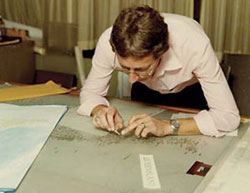Lettering and scribing

Methods of lettering
Before World War II, the only means of displaying text information on a map was by hand lettering. This was done on cotton linen material using crow quills, and later steel nibs. The lettering was effected strictly in accordance with in-house styles. The size of the lettering was measured in fractions of inches rather than the point size measurement of post-war times.
The lettering to publication standard was very challenging and time consuming. Generally, the standard was so high that users had difficulty believing the work was hand crafted.
New techniques were incorporated after World War II. These included various forms of photomechanical and adhesive-backed lettering.

This new process involved ordering specific text at certain point sizes, fonts and boldness according to specifications.
The order was then processed photographically from sets of master fonts and imaged onto very thin clear film backed with adhesive and paper.
Once received, the draftsman was able to cut each piece of text using a scalpel and adhere it to the correct position onto a stud-registered clear film base. This type overlay was registered with other line work and mask overlays.
Benefits of photo-lettering over hand lettering:
- speed of laying out type (after skills and procedures were improved)
- consistency of fonts and sizes throughout individual maps and series of maps
- type remained black: hand lettering required touching up with a pen to maintain black opacity
- lower level of skill required to achieve a good result.

Scribing
A line drawing tool was extensively used during the late 1970s and the 1980s in the Survey Office in the process of scribing line work onto a negative emulsion. This was beneficial as it reduced the number of photographic steps previously needed with pen and ink line work to print a map.
The technology used machine-precisioned sapphire tips incorporated into a swivelling platform. Varying widths of the tips were used according to line width specifications.
A reverse reading, photogrammetric generated image was photographically copied onto a negative emulsion film. A skilled draftsman could then scribe exactly over the relevant lines of the image.
The scribing process produced a crisp, consistent line and made free flowing curves, such as contours or creeks, look entirely natural in their shape.
The negative emulsion overlay was stud-registered in combination with other scribe, type or Rubylith mask overlays. This was according to predetermined colour specifications.
Related links
- Learn about Queensland’s mapping history.
- View images of instruments and equipment used to survey and map Queensland.